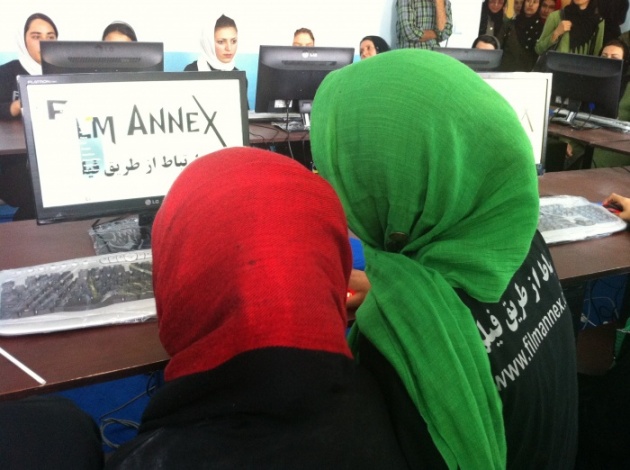Today, The New York Times' writer Graham Bowley opened his article, Potential for a Mining Boom Splits Factions in Afghanistan, with this sentence: “If there is a road to a happy ending in Afghanistan, much of the path may run underground...”
The article has a positive note of hope, but Mr. Bowley seems to avoid the solution to the issue. After nearly a year of work and collaboration with Roya Mahboob's Afghan Citadel Software Company and as we are about to open our fifth Internet classroom in Herat, I'd like to share my insights on this specific sentence and offer a set of solutions later on in this blog.
- If there is a road to a happy ending in Afghanistan: Which country actually has an ending, whether it is bad or good? Did Germany, Italy, or Japan have happy or bad endings after their defeat in WWII? Did the defeat pave the road to reconstruction and wealth?
- Much of the path may run underground: What about the value of over 30 million Afghan people with a median age of 18 years old versus the American median age of 36.9, and the European one at 37.7?
Afghan women and men must realize they have an incredible potential to abandon corruption and embrace education. On our end, we can provide Afghanistan with IT infrastructures, reliable hosting services, improved communications, and Internet access. We can also both benefit financially!
A strong and sophisticated flow of digital media, information and data will allow to curb corruption and improve productivity. Afghanistan doesn’t have to suffer from the bureaucratic mistakes of western societies where governmental institutions are the largest employers in the country, where governmental agencies become a form of welfare and can't take decisions to improve performance and productivity without initiating social unrest.
The Afghan Development Project was founded by Film Annex and Afghan Citadel Software Company to provide this IT infrastructure in 40 schools in the area of Herat and connect 160,000 children to the World Wide Web.
Now read carefully, OK?
The Afghan Development Project is financed by advertising funds generated by digital media like blogs and videos. Just like online film platforms as Film Annex, The Huffington Post and The Daily Beast finance themselves. It is not a surprise that the merge of Newsweek and The Daily Beast lead to using the Daily Beast website instead of Newsweek's. It is not a surprise that AOL's acquisition might lead to a global re-branding of The Huffington Post image.
On September 1st, Angela Shah published an article on Newsweek/The Daily Beast called In Afghanistan, Roya Mahboob Connects Girls With Computers. She nailed it! Angela Shah wrote a fantastic article on Afghanistan, touching both good and bad sides, but leaving room for a serious, objective and CONSTRUCTIVE conversation about what the country has to offer: Girls with Computers.

Picture: Courtesy of Angela Shah*
Film Annex is doing its part and doing it as a for profit investment. Film Annex's team in Afghanistan shoots videos of each school before and during the renovation and at the opening ceremony. The videos are edited in New York City and turned into 2-4 minute professional documentaries. They are broadcast on The Afghan Development Web TV along with other positive stories from NATO TV, and interviews with Thought Leaders from all over the world. This content is associated with valuable pre-roll video advertising from companies like Tremor Media, Yume, ADAP, Altitude, and 20 more international Ad-Networks. The advertising revenues generate the profits that allow Film Annex to grow its involvement and investment in Afghanistan.
On the other end of the cable, in Afghanistan, we are also in the process of training students and hiring writers and cinematographers to provide professional content and allow them to get rewarded with micro-scholarships paid with Mobile Money Payments. The wealth is redistributed in proportion based on the quality and skills of the content providers, who can be 12-year old students writing a paper or young cinematographers shooting a soccer game.
There are reasons why professional writers like Graham Bowley and Angela Shah select specific topics, keywords, links, and images for their articles. This is all part of a SEO optimization strategy that benefits their publishers, like NYTimes.com or DailyBeast.com. It is our job to teach those techniques to Afghanistan women, men, and students, and make sure that 30 million people with one half the median age of Europeans and Americans can learn and position themselves as thought leaders in valuable subjects.
Curious to see how it works? Just go on Google Videos and search the terms Afghanistan Education or Afghanistan Economy. You will see how a company like Film Annex can establish their keyword supremacy on very relevant current news within a few weeks. Yes, we can teach Afghan students how to achieve financial independence and Afghanistan institutions how to defeat corruption. We can even invite those who oppose our beliefs to have a civil conversation online, measure their buzz, and response on those topics. It generates advertising revenues that can further fund IT infrastructure and the educational system of Afghanistan.
This is not a hope for financial grants and donations. This is a self sustaining system that is working now with people and human resources and makes Afghanistan's mining and natural resources, corruption, and security be seen from a different prospective. In my blog, Traffic control of Afghanistan Education and Economy, I explain how we do it at Film Annex.
On a lighter note, 17 million Afghan citizens use cellphones and Angry Birds is a very popular game! As Angela Shah mentions in her article: “Let’s give the kids the Internet and let them choose what they want their future to be,” Rulli says. “I have three kids. I know ‘Angry Birds’ is a stronger weapon against the Taliban than anything else.”



